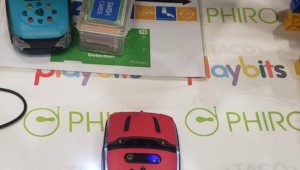The Transition from Cursive to Coding

To celebrate Computer Science Education Week (December 4-10), we’re bringing you a series of posts highlighting both the benefits of computer science education and fun ways for teachers of all backgrounds and skill levels to give their students computational thinking skills. Stay tuned for more like this throughout the week!
My son missed a day of school last week, and when he returned, his teacher gave him directions for his makeup work that were written in cursive. He returned to that teacher later in the day, and this exchange took place:
Son: Mrs. Soandso, excuse me, I‘m sorry, but I can’t read your writing.
He gave the note back to her. She smirked at him with a disapproving look. (His words.) Another student who didn’t learn to read or write cursive. She then looked at the note and was a bit puzzled. Something was wrong. Finally . . . .
Mrs. Soandso: Why didn’t you bring this to me sooner? I can’t remember what I wrote!
She couldn’t read it either! Cursive. Indecipherable, even to its own writer.
Its usefulness heated up in our house last week (because we don’t have real things to keep us up at night).
“It was difficult for doctors to give up leeches for modern medicine, but after the witch uprising was put down, it seemed like the right thing to do. We can shed cursive in the same manner.”
That is how I waded into the deep end of the Great Cursive Debate 2013 pool last week, but old-school English teachers and grammarians (“old” implied) on Reddit and other forums fought back with rather vicious attacks, mostly ad hominem in nature. I was called an English-language traitor and much worse. Their invective mudslinging language was right out of Star Wars (“wretched hive of scum and villainy”) and True Grit, the new one, not the old one (“You, sir, are the rodeo clown from Yell County!”). Thank you dictionary.com and urbandictionary.com for translating some of the insults for me. I was undaunted, though. They were empowered with righteousness. I had rightness on my side.
Their arguments to maintain cursive instruction in the grade school curriculum can be lumped into these airtight, data-driven arguments:
- It’s tradition. (Logical fallacy in determining merit.)
- I had to learn it. (What’s your position on Pluto as a planet?)
- It lets you write faster! (Myth.)
- Heaven forbid we actually make students do something hard. (You’re just saying words now.)
- It’s our signature. How will people know it’s really us? (You’re the reason we have captcha.)
- It’s beautiful. (Really? Don’t confuse cursive with calligraphy.)

Meanwhile, in Estonia . . . .
Students are learning to write code in first grade! Estonia, also known as “E-stonia”, is not just a technology-driven country (that has given us Skype among other things), but also ranks above the U.S. in reading, math, and science scores. Parmy Olsen, of Forbes, writes, “The idea isn’t to start churning out app developers of the future, but people who have smarter relationships with technology, computers and the Web .”
If we’re looking for areas to replace outdated skills with 21st-century skills in the curriculum, this would be Ground Zero. Estonia’s first graders are learning the logic skills necessary for coding at the later grades. That’s uber practical for the 21st Century.

Reasons to Code
Madeline McSherry of Slate says it best: “Coding is the hottest skill on the job market, the modern-day language of creativity, and a powerful force in the economy.”
Here are four reasons why I believe students should be coding:
- Language Study: Coding is the most important language in the world right now. It’s the language that enables the machines and software that we use every day.
- Cross Discipline Benefits: This isn’t just about technology. All fields… art, music, exercise… have programming needs. In fact, it’s the ultimate creative outlet for the arts in digital media.
- Entrepreneurship: The list is long of self-made youth entrepreneurs on the internet. Coding opens that door wide open. There doesn’t have to be a gap between haves and have nots here.
- Future Ready: Coding is a future-ready job skill for all disciplines. Who’s hiring coders? All of these people:
Ian Quillian of Mindshift identifies four other reasons to code:
- Subject Mastery, need it before you can code
- Systems Thinking, in the inputs and outcomes of programming
- Collaboration, programming is often done by a team
- Passion, students can take their programming skills into any field that they are passionate about

Programming pushes students to research, plan, outline, collaborate, test, troubleshoot and retest. It’s brain intensive language study that requires syntax and style. It’s the application of the theoretical with concepts, proofs, and strategies.
If the programming language students are studying were to become obsolete, they would still be equipped with programming skills, and that’s essentially all that’s necessary to learn new languages quickly.
Where to Start
Here’s a good (short) list for parents and classroom teachers who want to get their Generation Z students involved in coding right away.
My own kids (8th-grade girl and 6th-grade boy) are both learning code through Code Academy. In less than a month, they have gone from having only basic awareness about coding to acquiring rather advanced skills (way over my head). We have a standing house rule for our kids: If they want to use anything that runs on code (computer, smartphone, gaming console), they have to complete at least one Code Academy lesson for the day. It’s never an issue, though. At. All. They are intrigued by coding and find it very cool in understanding how it works and in watching their own codes work. You know, those same feelings you get when you write in cursive.
During the height of my cursive writing debate last week, I asked my kids which was more important to learn, cursive writing or coding. They looked at me like this was some sort of trick question, like I had lost my mind. Like this was a grasshopper-snatch-the-pebble-from-my-hand-and-become-the-master test. Then they fell on the floor laughing.
“Seriously, Dad? You’re kidding, right?”
“Cursive is basically just a font, Dad!”
“Can we also learn how to write in Helvetica or Impact or Verdana or Windings?”
“We might need that one day!”
“Is BeDazzled a font?”
“Can we learn to write in BeDazzled?”
“Yeah, but only if we can use the BeDazzler!”
For more, see:
- How Do We Prepare Teachers To Teach Coding?
- 10 Coding & Computer Science Blogs to Bookmark
- Getting Smart on Coding for College & Career Readiness
This post was originally published in May, 2013.
Stay in-the-know with all things EdTech and innovations in learning by signing up to receive the weekly Smart Update.




Melissa Meverden
There is room for coding and for cursive! Absolutely, being able to type and code proficiently is an awesome skill for our students. But cursive DOES have benefits, though the weak arguments you highlighted in this article certainly don't explain why. A cursory Google search will show you that research suggests that cursive handwriting can help stimulate motor skills and activate parts of the brain and stimulate memory that aren't impacted by typing [keyboard] notes instead; it can also help dyslexic students differentiate between similar letters. That said, I don't think that every third-grader needs to master perfect cursive technique - but young students could certainly benefit from handwriting practice and training. Many adults use a combination of print and cursive when they write - showing students how to do this, in order to save time and produce legible writing, is certainly valuable.
Replies
Erik Day
Thanks for the thoughtful comment, Melissa!